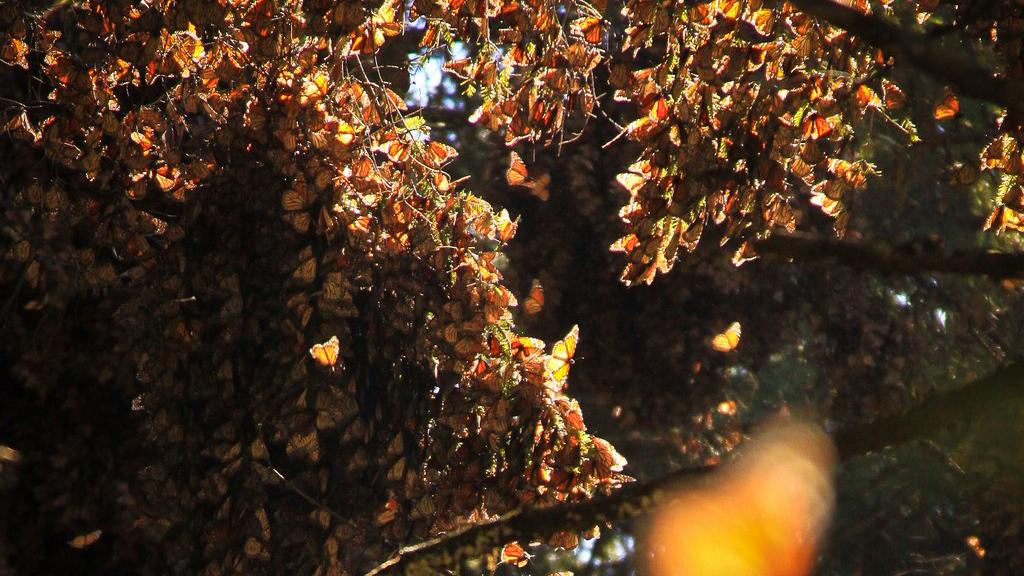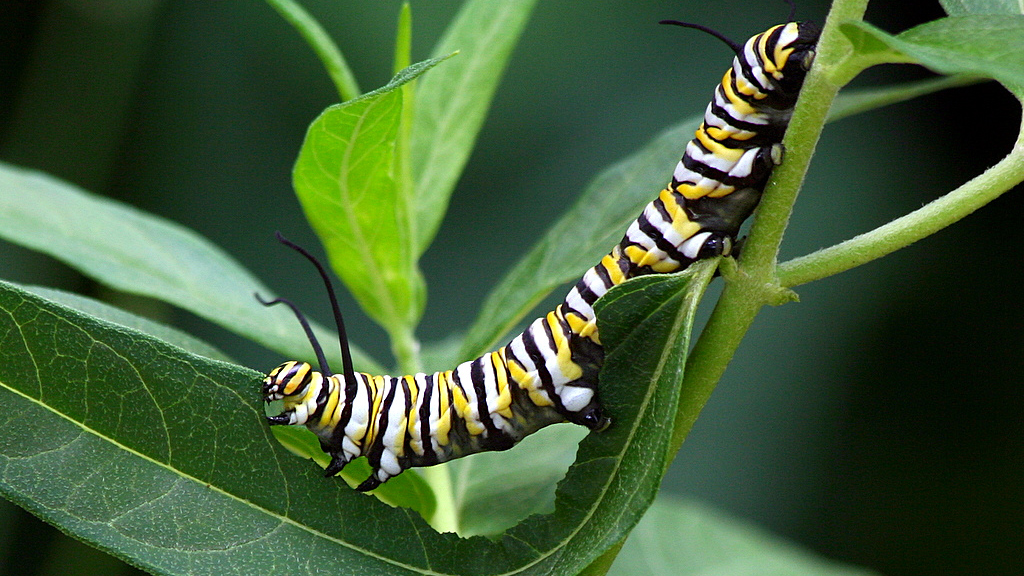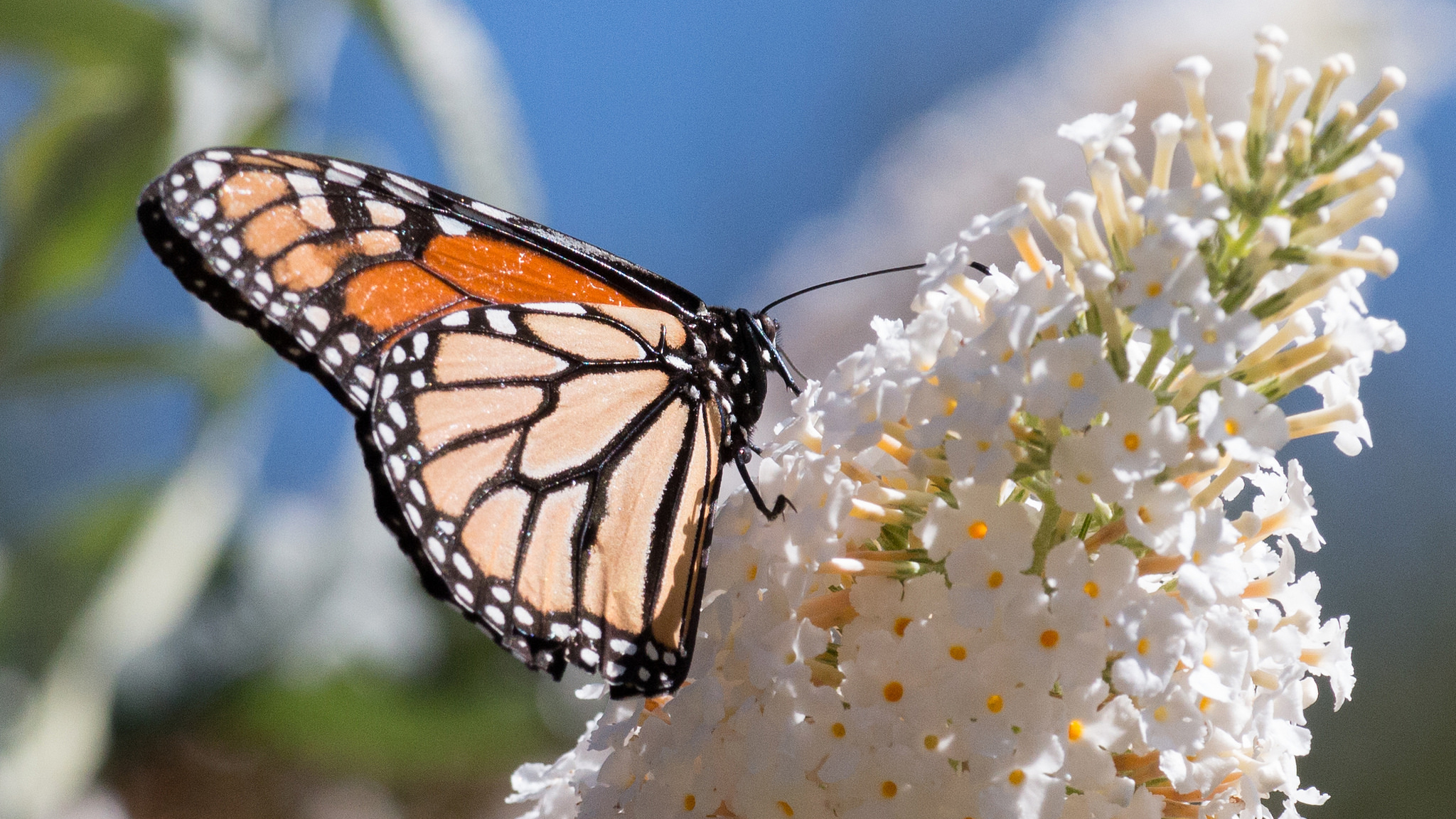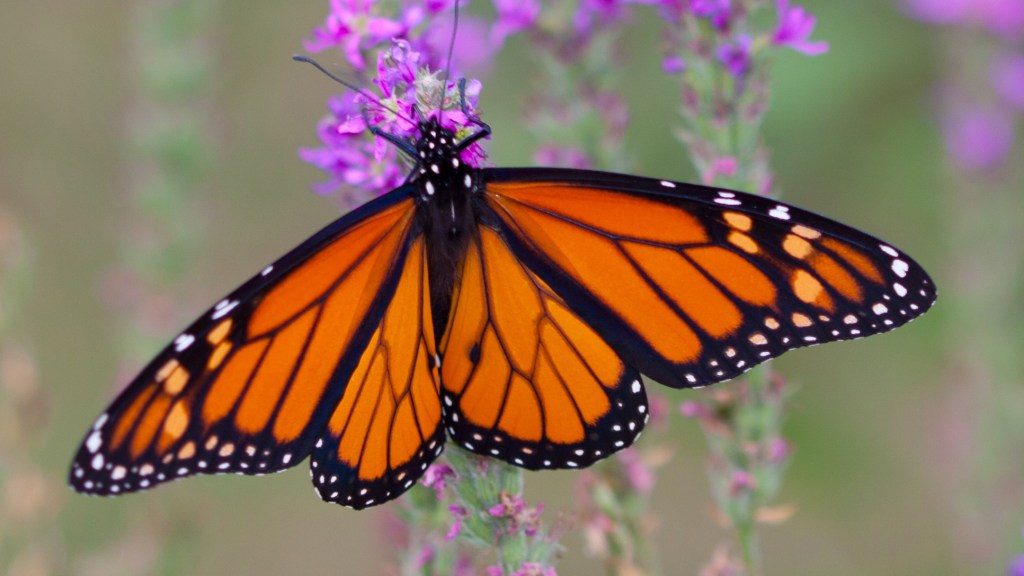Twenty years ago, monarch butterflies occupied so much area in Mexico during the winter you could see it from space. It totaled about 20 hectares, or almost 50 acres, with millions if not billions of butterflies clinging to trunks and branches of trees.
Today, that area is around 4 hectares. The previous year had 1.1 hectares, says Brice Semmens, Assistant Professor at the Scripps Institution of Oceanography at the University of California San Diego.
Semmens was the lead author on “Quasi-extinction risk and population targets for the Eastern, migratory population of monarch butterflies” published recently in the journal Scientific Reports. It is one paper in a long line of sobering butterfly news.
The monarch likely won’t ever become extinct, Semmens says. Small populations live scattered throughout Mexico, the central U.S. and Canada, and some were moved to places as far away as Hawaii and New Zealand.
But the massive eastern migrations between central Mexico and Canada that have inspired people for centuries could be lost.
Semmens’ paper used expert opinion to determine how little occupied winter habitat in Mexico would be needed to sustain a viable migratory population – and at what point it simply may not bounce back.

The authors used estimates of extinction rates with various overwintering sizes, and conclude monarchs need about 6 hectares, or about 15 acres, to cut the risk in half.
But in order to understand how to boost overwintering numbers, people must first understand what hazards the eastern monarch faces.
Semmens and University of Minnesota monarch expert Karen Oberhauser recently walked the Cool Green Science Blog through each threat, as well as some possible solutions.
Habitat Loss
This one isn’t a surprise. Many North American species face some kind of habitat loss, but the eastern monarch is struggling throughout its three-country migration route.
In the winter, the butterflies need insulated cover in the form of dense Mexican forests. While the area is protected by the Mexican government, its edges are still being eaten away by illegal logging.
But also critical are the other migratory stages. In each one between Mexico, the Midwestern U.S. and southern Canada, monarchs need milkweed. They can only reproduce with the flowering plant.

And since each annual migration might create four or even five generations of monarchs, less milkweed directly correlates to fewer butterflies, according to Oberhauser. Unfortunately, the plant has been effectively removed by the millions from most agricultural fields and neighboring areas throughout the Midwest.
“The hopeful thing is that monarchs can really use habitat in a lot of different places,” she says. “It’s not like we’re talking about spotted owls that need hundreds of acres of untouched forest. They can find a milkweed plant growing in a crack in a sidewalk.”
Climate Change
Monarchs suffer under drought and severe storms, two weather events becoming more common with climate change.
“If you imagine an EKG or something, a line going up and down, insect populations in general are very erratic,” says Oberhauser. “They are very driven by weather conditions and what we call stochastic variation, variation we don’t have control over and can’t predict.”
The biggest risk with storms is freezing to death. Butterflies can survive temperatures down to about 17 degrees Fahrenheit if the cold is dry. But temperatures of about 25F with rain often mean death. A single storm in 2002, for example, killed almost 80 percent of the monarch population.
“That year the population was pretty high,” Oberhauser says. “But two years ago when the population was down to under 1 hectare, if we lost 80 percent, the number might have been too small to be a viable population.”
Pesticides and Herbicides
Milkweed used to grow scattered throughout corn and soybean crops across the Midwest. But more efficient agriculture practices and products such as Roundup have nearly eliminated monarch habitat, according to Semmens.
“It’s not that the use changed, it’s still agriculture, but the weed control changed and made it hard for monarchs,” he says.

Monarchs are also suffering from something called neonicotinoids, a relatively new class of insecticides with poison growing in all tissues of the plant. They make the plant itself poisonous to insects.
So what can you do?
Leaders of all three North American countries have decided monarchs are a priority. As a result, the U.S. government, through the departments of the Interior and Agriculture, are creating strategic goals for increasing habitat.
The U.S. needs about 1.5 billion new stems of milkweed, or about 500 million new plants, to help reach the 6 hectare overwintering goal, says Wayne Thogmartin, a research ecologist with the USGS.
“It will require participation from all sectors of society,” he says. “If we try and rely on any single sector we won’t reach our goals. If we say this is an agricultural problem and we need to rely on them to solve it, it won’t get solved. If we say we will achieve this by having everyone plant milkweed in their backyard, it won’t solve the problem. We need everyone’s participation.”
But each person can make a difference.
Here are a few places the researchers suggest to start:
- Create habitat in your backyard, school or office. If you can, remove some grass and put in a garden. Each new plant makes a difference.
- Sign up for monarch citizen science projects and collect data for researchers. For more information, go to monarchjointventure.org.
- Ask before you buy. If you want to plant a pollinator-friendly garden, ask to be sure the seeds or plants weren’t treated with neonicotinoids.
- Talk to your friends, neighbors and relatives.
- Donate to organizations working for conservation of habitat including The Nature Conservancy, the Monarch Joint Venture and the Monarch Butterfly Fund.




Can someone tell me where to buy Milkweed around Albuquerque? I have been looking for years and having no luck growing it from seeds.
Last year my husband & I planted milkweed raising & releasing 54 monarchs. It was the first time we’ve done something like this & we loved it! Living in southern middle Tennessee it is sometimes difficult dealing with neighboring farmers who are dead set on removing all milkweed, trying to explain to them the necessity for the survival of the monarchs is like talking to a brick wall. This year we have 3 seperate gardens planted with milkweed, a total of over 100 plants so far, as well as other pollenator flowers for not only the monarchs but other butterflies & hummingbirds to enjoy as well. It’s not much, only a small part in the effort to save the monarchs, I only wish others would do the same.
I planted an acre of wildflowers through a USDA pollinator grant and a percentage of milkweed plants to support the Monarchs in particular. My wife and I are working on making our backyard a bird and pollinator refuge, too – including a year round / heated water source – bubble-rock. fountain. I’m a beekeeper and continue to do whatever I can in supporting honeybees and butterflies, plus a volunteer and member of the Nature Conservancy.
I have planted my front yard with many types of milkweed, the Monarchs love it, last year my granddaughter and I bought a butterfly house and were able to raise 9 Monarchs which we released.
This year we have 18 Chrysalis getting ready to hatch and I just noticed a couple of Monarchs laying more eggs on the milkweed. That’s not really a lot, but if everybody would plant a couple of milkweed plants we could possibly get somewhere..
The past 2 years I have planted milkweed for the monarchs and got lots of monarch caterpillars. They strip the plants bare and then disappear. Where do they go? Do they find something else to eat?? I have never seen them make a crysallis but would love to see that part.
I/we appreciate your post. We are growing and distributing Milkweed and other food source plants in our university greenhouse to enhance the Tulsa area favorability for migrating Monarchs.
Every year I buy flowers for our church’s Children’s butterfly garden. Is there a chance that the flowers were treated with neonicotinoids? Is there a law that states flowers are treated, so when stores owners purchase them they would know?
“Monarchs are also suffering from something called neonicotinoids, a relatively new class of insecticides with poison growing in all tissues of the plant. They make the plant itself poisonous to insects.”
Is this statement accurate? There’s no “BT” biotech trait for neonicotinoids. There is seed treatment that contains neonics- but it’s only systemic for a short period of time and the plant doesn’t actually grow the pesticide in the plant.
How can anyone find seed for milkweed? I know several stores have had no luck in finding a source. I know many people would plant them if seeds were available.
I sometimes ask the nursery if the flowers they sell have been treated with pesticides and they don’t seem to know.
I live in Central Virginia and only saw Monarchs in the fall during the southbound migration. It’s my understanding that the Monarchs only need the milkweed during their northern migration when they are breeding. Is there a map that shows the paths of the various south wintering populations? If I’m not in one of the paths, I’m not planting mikweed! Someone brought it to my previous yard thinking it would help the Monarchs. It’s an extremely vicious spreader that will take over your garden and yard. I never saw any buttefuly caterpillars on the milkweed.
My favorite peev these days is the destruction of roadside habitats. In my state, North Carolina, we seem to be fanatics about our roadsides, mowing down to a fraction of an inch anything growing that might possibly somehow interfere with the “safety” of our roads. We now have these behemoth destruction machines that not only cut down anything growing, but often eliminate it and gouge into the soil. To cut back tree branches that might interfere with roadside visibility, these machines blast apart the branches, making it look like the trees exploded. All in all this is not a pretty picture, aesthetically as well as environmentally. In the past, we used to have a wide variety of native plants, making a road trip beautiful as well as functional. But now we get rid of anything that could be food for our pollinators, and just forget about milkweed to sustain the Monarch larvae. I am interested in any campaign that would stop the foolishness of all this unnecessary mowing that we taxpayers pay for.
Recently I was in Italy, delighting in the roadside flowers, including red poppies. And while traveling in some other states I have noted that several do not have the mowing mania that my state does.
If we leave the roadsides to native plants, there will be plenty of food for the pollinators, and possibly milkweed will make a comeback, too!
it would be helpful if you outlined where. I think if I planted milkweed here in AZ it would be a useless gesture.
After getting multiple emails my daughter and I decided to help. Where we live in Villa Park Ca. We took a section of our back yard and with the help of our friends at Blue Hills Nursrey in Whittier we build a butterfly garden. We have also set up a terrarium to raise the Monarchs so the are protected from predictors. I would like to show pictures if someone would provide a link I can post them. We did this as an EarthDay project.
We need to do what we can to keep a healthy population of butterflies.